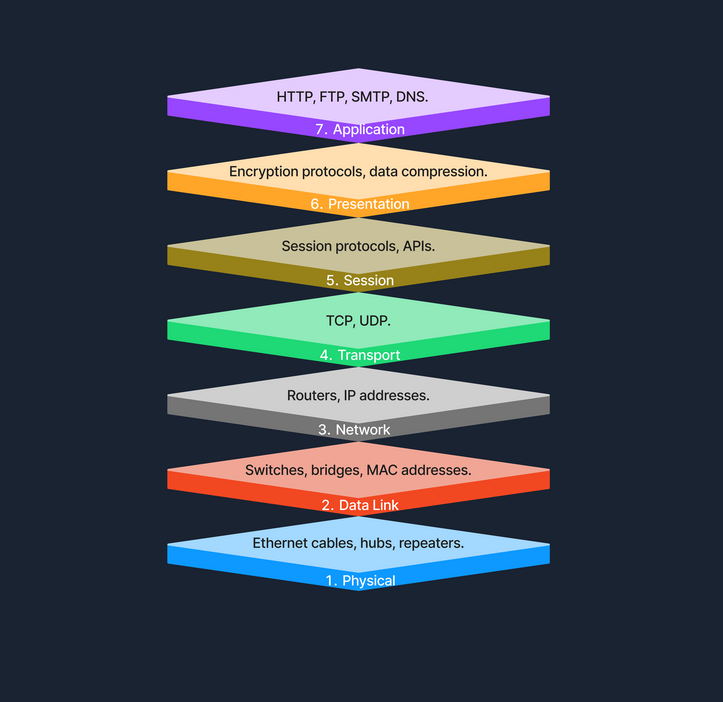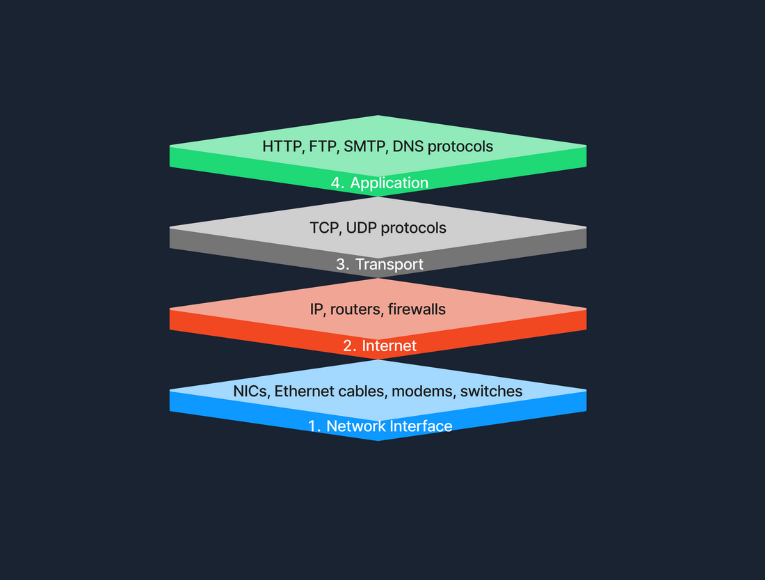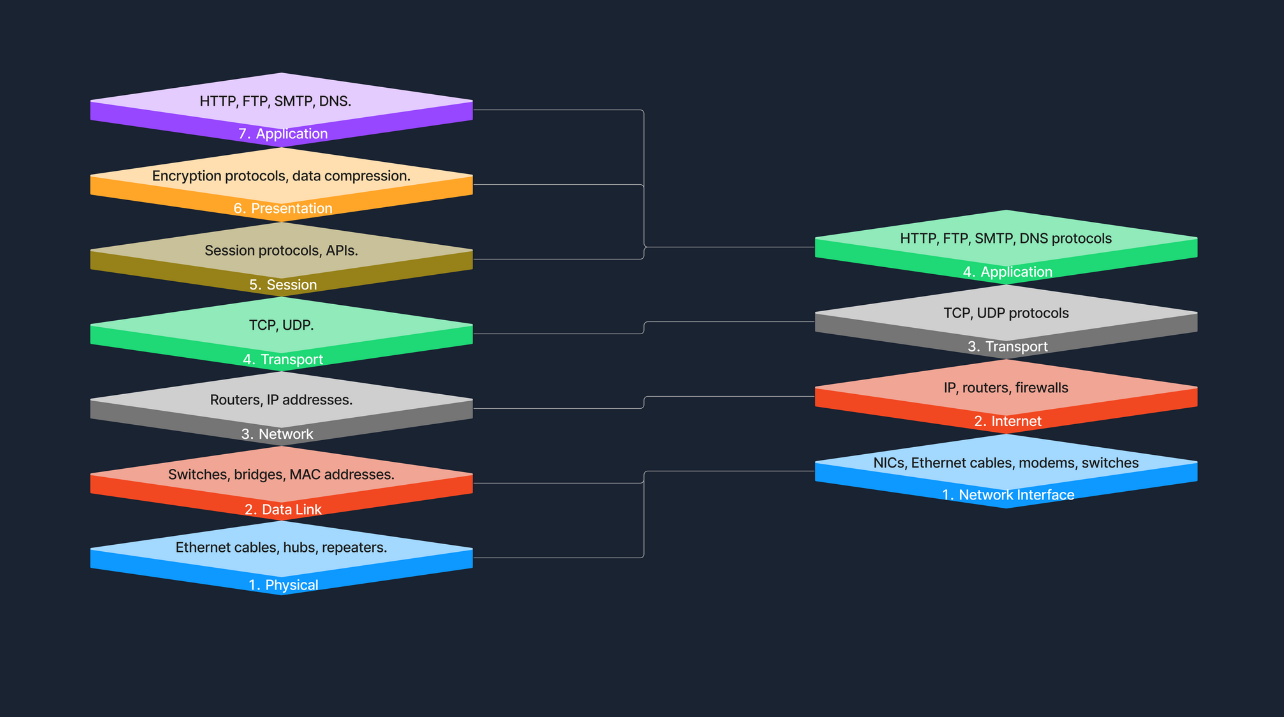Contents Page
Previous Section
Understanding the nuts and bolts of networking, is undoubtably important. However, many are not aware just how ubiquitous (everywhere) networking has become. The incredibly complex technology stack in use today - what is seen across consumer electronics, multimedia devices, hardware, software, and firmware - was built in conjunction with (or on top of) the TCP/IP stack.
Furthermore, this section details a few key concepts that help to illustrate how networking fits into the wider ecosystem of technology. By discussing the OSI and TCP/IP models, some common network protocols used as rules and standards for data exchange and the various transmission methods that enable information to transverse efficiently and security across the network.
OSI Model¶
The Open Systems Interconnection (OSI) Model is a conceptual framework that standardises the functions of a telecommunication or computing system, into seven abstract layers. This model helps vendors and developers create interoperable network devices and software.
Below is the seven layers of the OSI model:
1) Physical Layer
2) Data Link Layer
3) Network Layer
4) Transport Layer
5) Session Layer
6) Presentation Layer
7) Application Layer

Seven Layers of the OSI Model
Physical Layer (Layer 1)¶
The Physical Layer is the first and lowest layer of the OSI model. It is responsible for transmitting raw bitstreams over a physical medium. This layer deals with the physical connection between devices, including the hardware components like Ethernet cables, hubs, and repeaters.
Data Link Layer (Layer 2)¶
The Data Link Layer provides node-to-node data transfer - a direct link between two physically connected nodes. It ensures that data frames are transmitted with proper synchronisation, error detention, and correction. Devices such as switches and bridges operate at this layer using, MAC (Media Access Control) addresses to identify network devices.
Network Layer (Layer 3)¶
The Network Layer handles packet forwarding, including the routing of packets through different routers to reach the destination network. It is responsible for logical addressing and path determination, ensuring that data reaches the correct destination across multiple networks. Routers operate at this layer, using IP (Internet Protocol) addresses to identify devices and determine the most efficient path for data transmission.
Transport Layer (Layer 4)¶
The Transport Layer provides end-to-end communication services for applications. It is responsible for the reliable (or unreliable) delivery of data, segmentation, reassembly of messages, flow control, and error checking.
Protocols like TCP (Transmission Control Protocol) and UDP (User Datagram Protocol) function at this layer. TCP offers reliable, connection-oriented transmission with error recovery, while UDP offers faster connectionless communication without guaranteed delivery.
Session Layer (Layer 5)¶
The Session Layer manages sessions between applications. It establishes, maintains, and terminates connections, allowing devices to hold ongoing communications known as sessions.
This layer is essential for session checkpointing and recovery, ensuring that data transfer can resume seamlessly after interruptions. Protocols and APIs (Application Programming Interfaces) operating at this layer coordinate communication between systems and applications.
Presentation Layer (Layer 6)¶
The Presentation Layer acts as a translator between the application layer and the network format. It handles data representation, ensuring that information sent by the application layer of one system is readable by the application layer of another.
This includes data encryption and decryption, data compression and converting data formats. Encryption protocols and data compression techniques operate at this layer to secure and optimise data transmission.
Application Layer (Layer 7)¶
The Application Layer is the topmost layer of the OSI Model and provides network services directory to end-user applications. It enables resource sharing, remote file access and other network services.
Common Protocols operating at this layer include:
- HTTP (HyperText Transfer Protocol) for web browsing
- FTP (File Transfer Protocol) for file transfers
- SMTP (Simple Mail Transfer Protocol) for email transmission
- DNS (Domain Name System) for resolving domain names to IP addresses.
The DNS Layer acts as an interface between the network and the application software.
Example of Sending a File Across Network Layers¶
When sending a file over a network, several steps occur across different layers of the network model.
The process for sending a file across network layers goes as follows:
1) The Application Layer, which initiates the file transfer request.
2) The Presentation Layer encrypts the file to ensure its security during transmission.
3) The Session Layer then establishes a communication session with the receiving device.
4) The Transport Layer, the file is broken down into segments to ensure error-free transmission.
5) The Network Layer takes over to determine the best route for transferring the data across the network.
6) The Data Link Layer encapsulates the data into frames, preparing it for node-to-node delivery.
7) The Physical Layer handles the actual transmission of bits over the physical medium, completing the process.
TCP/IP Model¶
The Transmission Control Protocol/Internet Protocol (TCP/IP) Model is a condensed version of the OSI Model, tailored for practical implementation on the internet and other networks.
Below is the four layers of the TCP/IP Model:
Link Layer:¶
The Link Layer is responsible for handling the physical aspects of network hardware and media. IT includes technologies such as Ethernet for wired connections and Wi-Fi for wireless connections.
The Link Layer corresponds to the Physical and Data Link Layers of the OSI model, covering everything from physical connection to data framing.
Internet Layer:¶
The Internet Layer manages the local addressing of devices and the routing of packets across networks. Protocols like IP (Internet Protocol) and ICMP (Internet Control Message Protocol) operate at this layer, ensuring that data reaches its intended destination and determining local paths for packet transmission.
This layer corresponds to the Network Layer of the OSI model.
Transport Layer:¶
The Transport Layer, the TCP/IP model provides end-to-end communication services that are essential for the functioning of the internet. This includes the use of TCP (Transmission Control Protocol) for reliable communication and UDP (User Datagram Protocol) for faster, connectionless services.
This layer ensures that data packets are delivered in a sequential and error-free manner, corresponding to the Transport Layer of the OSI Model.
Application Layer:¶
The Application Layer of the TCP/IP model contains protocols that offer specific data communication services to applications.
Protocols such as HTTP, FTP, and SMTP enable functionalities like web browsing, file transfers, and email services.
This layer corresponds to the top three layers of the OSI model (Session, Presentation, and Application), providing interfaces and protocols necessary for data exchange between systems.

Four Layers of the TCP/IP Model
Comparison with the OSI Model¶
The TCP/IP model simplifies the complex structure of the OSI model by combining certain layers for practical implementation. Specifically designed around the protocols used on the internet, the TCP/IP model is more application-oriented focusing on the needs of the real-world network communication. This design makes it more effective for internet-based data exchange, meeting modern technological needs.

How the OSI Model links TCP/IP Model
Example of Accessing a Website¶
When accessing a website, several layers of the TCP/IP model work together to facilitate the process.
The process of making access a website through the TCP/IP Model:
1) At the Application Layer, your browser utilises HTTP to request the webpage.
2) The request then goes to the Transport Layer, where TCP ensures the data is transferred reliably.
3) The Internet Layer comes into play next, with IP taking charge of routing the data from the device to the web server.
4) Finally, at the Network Interface Layer, the data is physically transmitted over the network, completing the connection that allows us to view the website.
Model Roles¶
In practical terms, the TCP/IP model is the backbone of network data transmission, actively employed across various networking environments. On the other hand, the OSI Model, while not directed implemented plays a crucial role as a comprehensive theoretical framework.
This helps demystify the complexities of network operations, providing clear insights and a structured approach to understanding how networks function. Together, these models form a complete picture, bridging the gap between theoretical knowledge and practical application in networking.
Protocols¶
Protocols are standardised rules that determine the formatting and processing of data to faciliate communication between devices in a network.
These protocols operate at different layers within the network models, each tailored to handle specific types of data and communication needs.
Below is some of the common network protocols and their roles in data exchange.
Common Network Protocols¶
Network Protocols are essential for defining how data is exchanged across networks. Each protocol operates at a specific layer of the OSI Model, ensuring structured and efficient data handling.
Below are some Common Networking Protocols:
| Protocol | Description |
|---|---|
HTTP (Hypertext Transfer Protocol) | Primarily used for transferring web pages. It operates at the Application Layer, allowing browsers and servers to communicate in the delivery of web content. |
FTP (File Transfer Protocol) | Facilitates the transfer of files between systems, also functioning at the Application Layer. It provides a way for users to upload or download files to and from servers. |
SMTP (Simple Mail Transfer Protocol) | Handles the transmission of email. Operating at the Application Layer, it is responsible for sending messages from one server to another, ensuring they reach their intended recipients. |
TCP (Transmission Control Protocol) | Ensures reliable data transmission through error checking and recovery, operating at the Transport Layer. It establishes a connection between sender and receiver to guarantee the delivery of data in the correct order. |
UDP (User Datagram Protocol) | Allows for fast, connectionless communication, which operates without error recovery. This makes it ideal for applications that require speed over reliability, such as streaming services. UDP operates at the Transport Layer. |
IP (Internet Protocol) | Crucial for routing packets across network boundaries, functioning at the Internet Layer. It handles the addressing and routing of packets to ensure they travel from the source to the destination across diverse networks. |
Transmission¶
Transmission in networking refers to the process of sending data signals over a medium from one device to another. To further understand this concept, let's examine the different types of transmission, the modes in which these transmissions can occur, and the media that carry the signals.
Transmission Types:¶
Transmission in networking can be categorised into two main types: Analog and Digital. Analog transmission uses continuous signals to represent information, commonly seen in traditional radio broadcasts. In contrast, digital transmission employs discrete signals (bits) to encode data, which is typical in modern communication technologies like computer networks and digital telephony.
Transmission Modes:¶
Transmission modes define how data is sent between two devices.
Different Transmission Modes include:
Simplex mode allows one-way communication only. E.g. from a keyboard to a computer where signals travel from a single direction.
Half-Duplex mode permits two way communication but not simultaneously. E.g. Walkie-Talkies where users must take turns speaking.
Full-Duplex mode used in telephone calls, supports two-way simultaneous communication allowing both parties to speak and listen at the same time.#
Transmission Media:¶
The physical means by which data is transmitted in a network is known as transmission media, which can be wired or wireless.
Wired media includes:
- Twisted Pair Cables (TPC) commonly used in Ethernet networks
- Local Area Network (LAN) connections; coaxial cables, used for cable TV and early Ethernet; and fibre optic cables, which transmit data as light pulses and are essential for high-speed internet backbones.
Wireless media on the other hand, encompasses the following:
- Radio-Waves for Wi-Fi and Cellular Networks
- Microwaves for satellite communications
- Infrared Technology (IR) used for short-term communications like remote controls.
Each type of media has its own specific use cases depending on the requirements of the network environment.
Exercises¶
Q: What layer of the OSI model is responsible for physical connections like Ethernet cables? (Format: two words)
A: Physical Layer
Q: + 0 Name the OSI layer that deals with logical addressing and routing. (Format: two words)
A: Network Layer
Q: Which protocol ensures reliable delivery of data and operates at the Transport Layer?
A: TCP
Q: At what layer do switches operate within the OSI model? (Format: three words)
A: Data Link Layer
Q: What layer of the TCP/IP model corresponds to the OSI model’s Application, Presentation, and Session layers? (Format: two words)
A: Application Layer
Q: Which layer of the OSI model manages data encryption and data format conversion? (Format: two words)
A: Presentation Layer
Q: Name a protocol used for web browsing that operates at the Application Layer.
A: HTTP
Q: Which OSI layer ensures the segments are transferred reliably and in sequence? (Format: two words)
A: Transport Layer